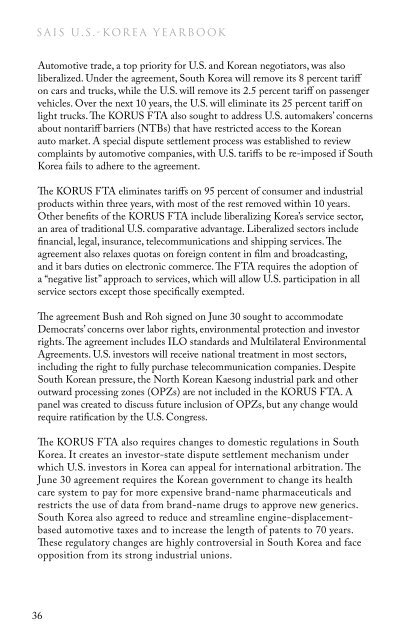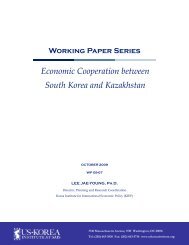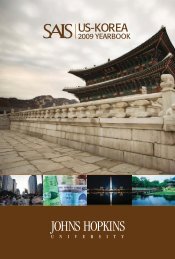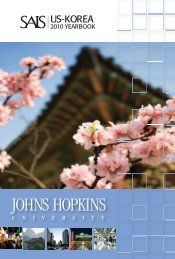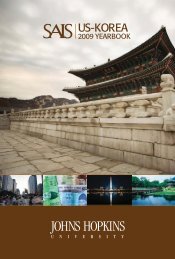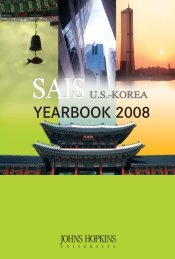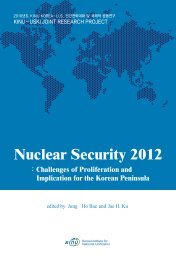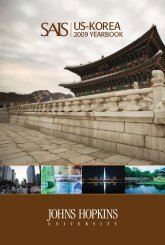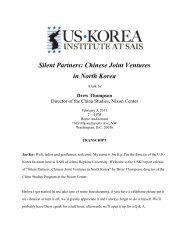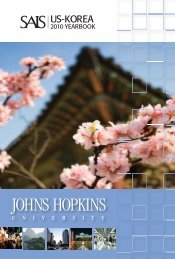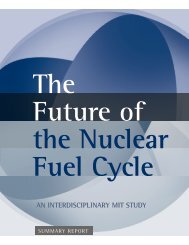YeArBooK 2007 - US-Korea Institute at SAIS
YeArBooK 2007 - US-Korea Institute at SAIS
YeArBooK 2007 - US-Korea Institute at SAIS
Create successful ePaper yourself
Turn your PDF publications into a flip-book with our unique Google optimized e-Paper software.
saIs U.s.-<strong>Korea</strong> YearbooK<br />
Automotive trade, a top priority for U.S. and <strong>Korea</strong>n negoti<strong>at</strong>ors, was also<br />
liberalized. Under the agreement, South <strong>Korea</strong> will remove its 8 percent tariff<br />
on cars and trucks, while the U.S. will remove its 2.5 percent tariff on passenger<br />
vehicles. Over the next 10 years, the U.S. will elimin<strong>at</strong>e its 25 percent tariff on<br />
light trucks. The KOR<strong>US</strong> FTA also sought to address U.S. automakers’ concerns<br />
about nontariff barriers (NTBs) th<strong>at</strong> have restricted access to the <strong>Korea</strong>n<br />
auto market. A special dispute settlement process was established to review<br />
complaints by automotive companies, with U.S. tariffs to be re-imposed if South<br />
<strong>Korea</strong> fails to adhere to the agreement.<br />
The KOR<strong>US</strong> FTA elimin<strong>at</strong>es tariffs on 95 percent of consumer and industrial<br />
products within three years, with most of the rest removed within 10 years.<br />
Other benefits of the KOR<strong>US</strong> FTA include liberalizing <strong>Korea</strong>’s service sector,<br />
an area of traditional U.S. compar<strong>at</strong>ive advantage. Liberalized sectors include<br />
financial, legal, insurance, telecommunic<strong>at</strong>ions and shipping services. The<br />
agreement also relaxes quotas on foreign content in film and broadcasting,<br />
and it bars duties on electronic commerce. The FTA requires the adoption of<br />
a “neg<strong>at</strong>ive list” approach to services, which will allow U.S. particip<strong>at</strong>ion in all<br />
service sectors except those specifically exempted.<br />
The agreement Bush and Roh signed on June 30 sought to accommod<strong>at</strong>e<br />
Democr<strong>at</strong>s’ concerns over labor rights, environmental protection and investor<br />
rights. The agreement includes ILO standards and Multil<strong>at</strong>eral Environmental<br />
Agreements. U.S. investors will receive n<strong>at</strong>ional tre<strong>at</strong>ment in most sectors,<br />
including the right to fully purchase telecommunic<strong>at</strong>ion companies. Despite<br />
South <strong>Korea</strong>n pressure, the North <strong>Korea</strong>n Kaesong industrial park and other<br />
outward processing zones (OPZs) are not included in the KOR<strong>US</strong> FTA. A<br />
panel was cre<strong>at</strong>ed to discuss future inclusion of OPZs, but any change would<br />
require r<strong>at</strong>ific<strong>at</strong>ion by the U.S. Congress.<br />
The KOR<strong>US</strong> FTA also requires changes to domestic regul<strong>at</strong>ions in South<br />
<strong>Korea</strong>. It cre<strong>at</strong>es an investor-st<strong>at</strong>e dispute settlement mechanism under<br />
which U.S. investors in <strong>Korea</strong> can appeal for intern<strong>at</strong>ional arbitr<strong>at</strong>ion. The<br />
June 30 agreement requires the <strong>Korea</strong>n government to change its health<br />
care system to pay for more expensive brand-name pharmaceuticals and<br />
restricts the use of d<strong>at</strong>a from brand-name drugs to approve new generics.<br />
South <strong>Korea</strong> also agreed to reduce and streamline engine-displacementbased<br />
automotive taxes and to increase the length of p<strong>at</strong>ents to 70 years.<br />
These regul<strong>at</strong>ory changes are highly controversial in South <strong>Korea</strong> and face<br />
opposition from its strong industrial unions.<br />
36<br />
<strong>Korea</strong>-U.s. fTa faCes UnCerTaIn fUTUre<br />
IV. eConoMIC IMPACT of THe Kor<strong>US</strong> fTA<br />
The KOR<strong>US</strong> FTA will make 82 percent of U.S. and 80 percent of South<br />
<strong>Korea</strong>n tariff lines duty free immedi<strong>at</strong>ely, with close to 99 percent of tariff<br />
lines becoming duty free within 10 years. In September <strong>2007</strong>, the ITC issued a<br />
report analyzing the economic impact of the KOR<strong>US</strong> FTA. Tariff cuts alone are<br />
predicted to raise U.S. GDP by slightly more than $10 billion, with merchandise<br />
exports to South <strong>Korea</strong> predicted to increase by $9.7–10.9 billion. Imports are<br />
also predicted to increase, but by several billion less.<br />
Trade in agricultural goods is expected to see the largest growth in percentage<br />
terms, with exports of me<strong>at</strong>, grains, oilseeds (such as soybeans), fruits and<br />
vegetables all expected to see substantial growth. If the issue of U.S. beef safety is<br />
resolved, the KOR<strong>US</strong> FTA could increase employment in the U.S. me<strong>at</strong> sector<br />
by up to 2 percent.<br />
U.S. textile and auto imports from South <strong>Korea</strong> are predicted to increase as a<br />
result of the FTA, but less than 1 percent of U.S. workers in these sectors are<br />
predicted to lose their jobs as a result of the agreement. In addition, as much<br />
as 85 percent of the increase in textile imports, 91 percent of apparel imports,<br />
and 57 percent of the increase in passenger vehicle imports are predicted to be<br />
diverted from other import sources.<br />
The high level of expected trade diversion has two important ramific<strong>at</strong>ions: (1)<br />
it reduces the likely number of jobs lost due to the FTA in import competing<br />
sectors, as total imports will increase by less than bil<strong>at</strong>eral imports, and (2) it<br />
reduces the overall economic gain from the agreement. If the drop in tariff<br />
revenue is gre<strong>at</strong>er than the gains from lowered prices, the FTA could potentially<br />
hurt the U.S. economy. The high level of predicted trade diversion raises<br />
questions about the economic justific<strong>at</strong>ion for the FTA.<br />
ITC projections should also be taken with a grain of salt. The ITC uses the<br />
Global Trade Analysis Project (GTAP) CGE model to calcul<strong>at</strong>e the effect of<br />
reducing or elimin<strong>at</strong>ing tariffs and tariff r<strong>at</strong>e quotas. Pravin Krishna, a professor<br />
of intern<strong>at</strong>ional economics <strong>at</strong> Johns Hopkins University’s School of Advanced<br />
Intern<strong>at</strong>ional Studies, has expressed doubt about the accuracy of such models,<br />
noting th<strong>at</strong> CGE models are only as good (or bad) as the elasticities they use.<br />
In addition, the GTAP model does not capture gains resulting from regul<strong>at</strong>ory<br />
improvements and the reduction of NTBs, key parts of the FTA. The model<br />
also fails to capture gains from increased foreign direct investment. The actual<br />
benefits may therefore be significantly larger (or smaller) than ITC estim<strong>at</strong>es.<br />
37


